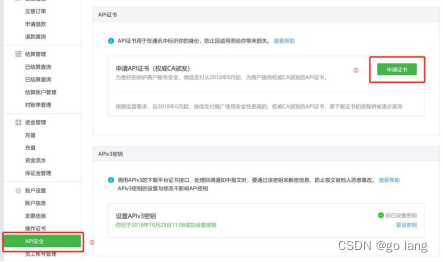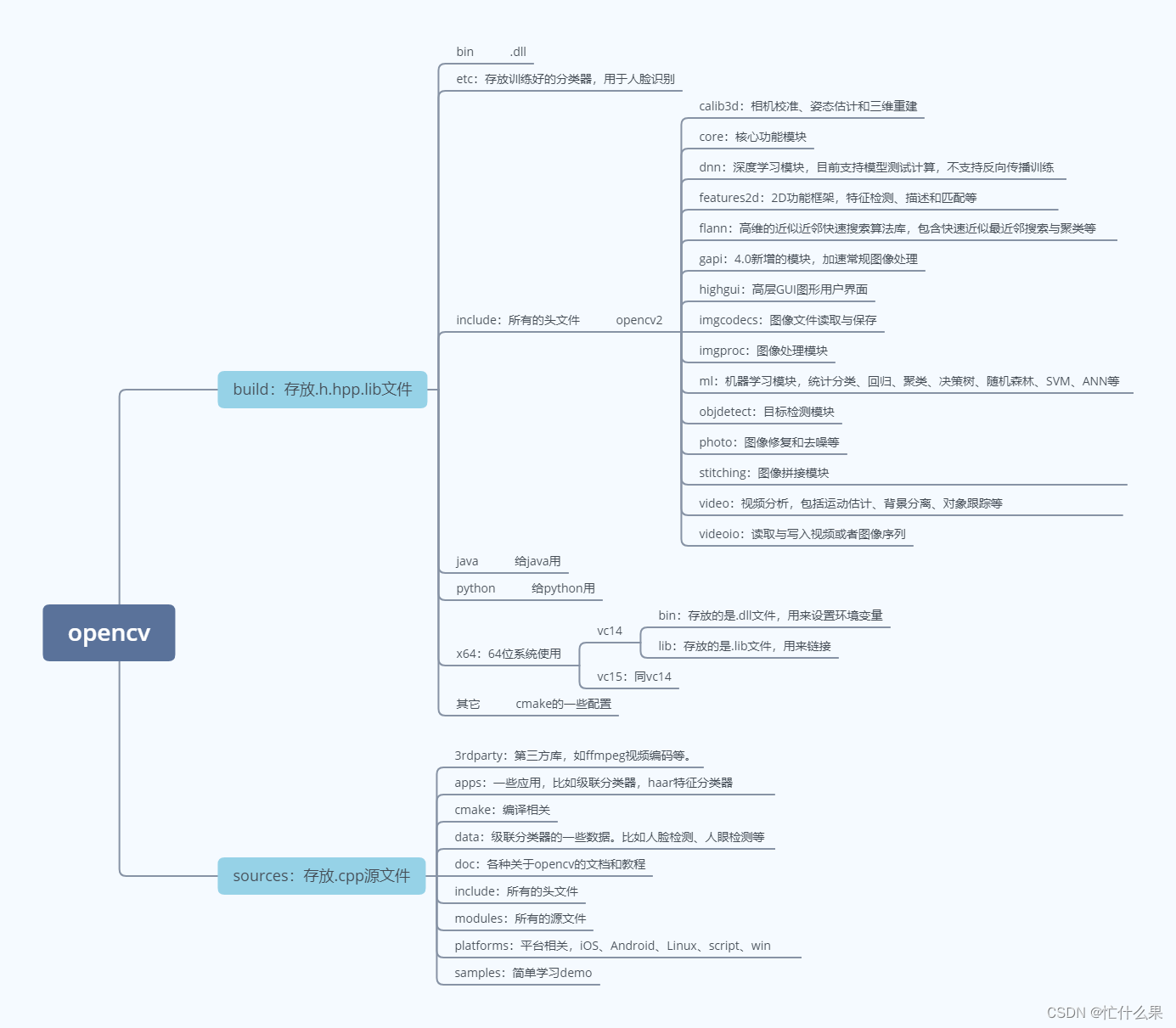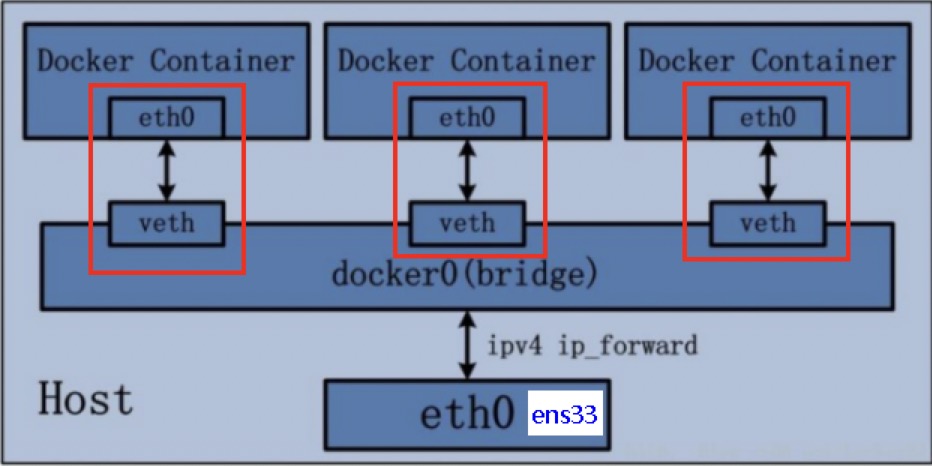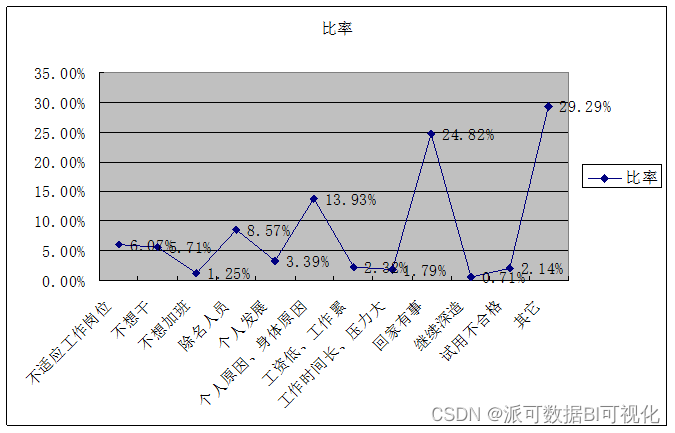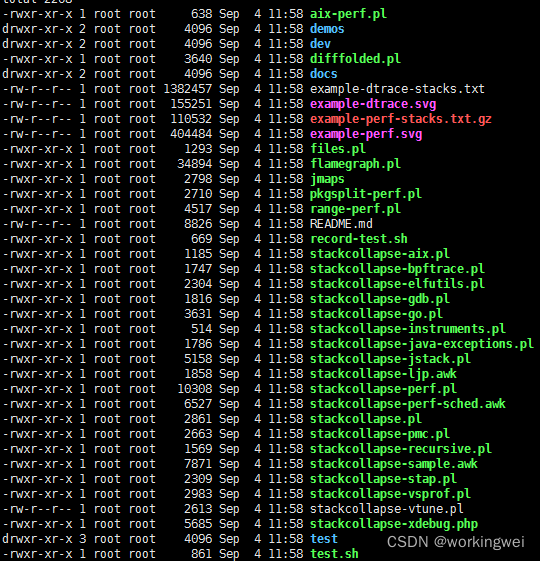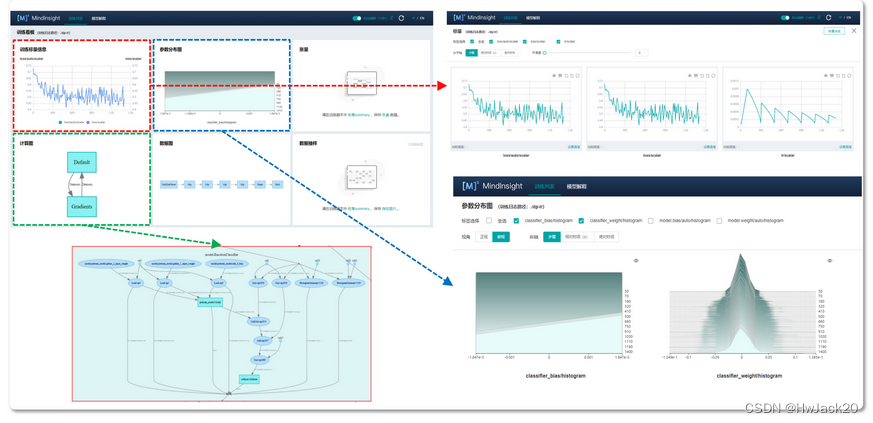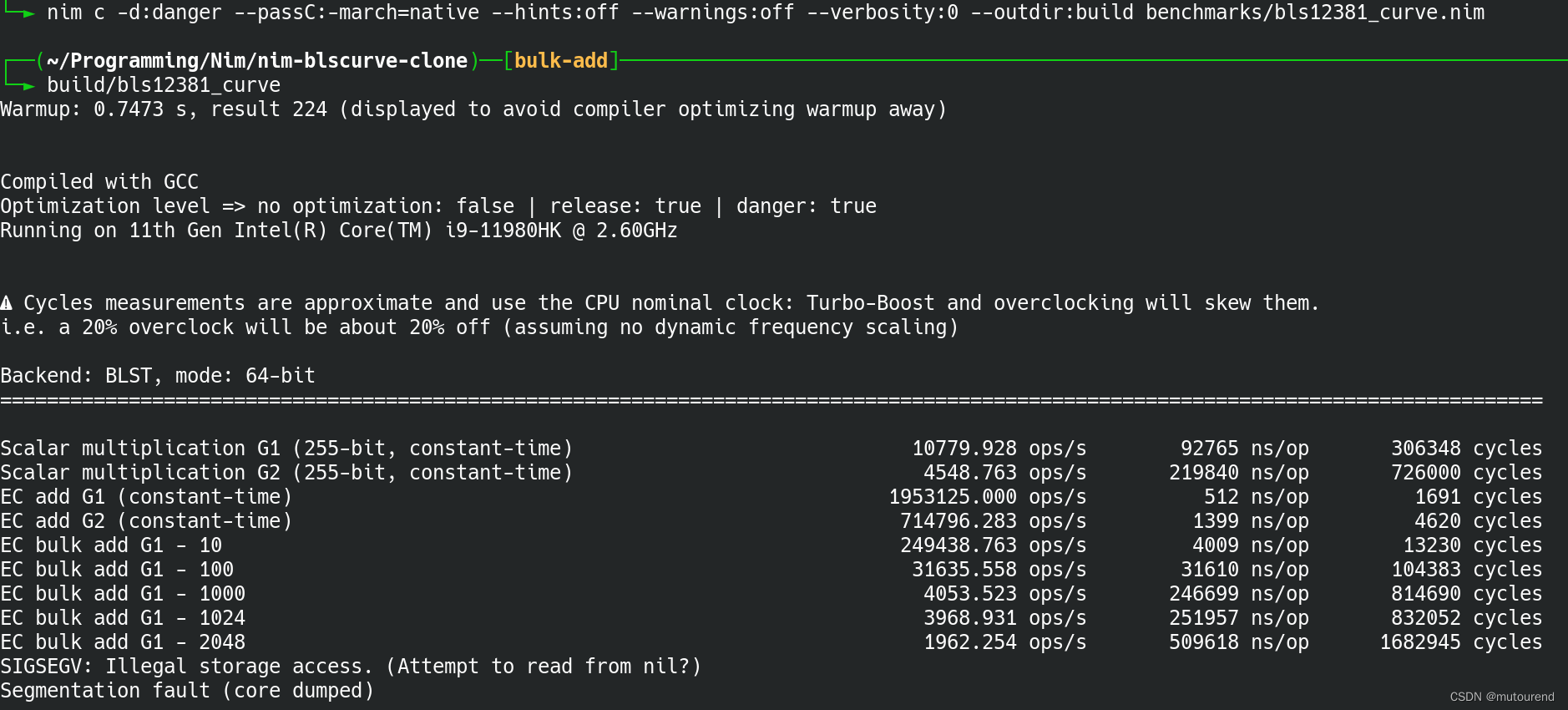TensorFlow2的层次结构
- Tensorflow的层次结构
- Tensorflow的低阶API示例
- 线性回归模型
- 准备数据
- 定义模型
- 训练模型
- DNN二分类模型
- 准备数据
- 定义模型
- 训练模型
- Tensorflow的中阶API示例
- 线性回归模型
- DNN二分类模型
- Tensorflow的高阶API示例
- 线性回归模型
- 定义模型
- 训练模型
- DNN二分类模型
- 定义模型
- 训练模型
- 参考资料
TensorFlow中5个不同的层次结构:即硬件层,内核层,低阶API,中阶API,高阶API。本文以线性回归和DNN二分类模型为例,直观对比展示在不同层级实现模型的特点。
Tensorflow的层次结构
TensorFlow的层次结构从低到高可以分成如下五层:
- 最底层为硬件层,TensorFlow支持CPU、GPU或TPU加入计算资源池。
- 第二层为C++实现的内核,kernel可以跨平台分布运行。
- 第三层为Python实现的操作符,提供了封装C++内核的低级API指令,主要包括各种张量操作算子、计算图、自动微分。如
tf.Variable,tf.constant,tf.function,tf.GradientTape,tf.nn.softmax… 如果把模型比作一个房子,那么第三层API就是模型之砖。 - 第四层为Python实现的模型组件,对低级API进行了函数封装,主要包括各种模型层,损失函数,优化器,数据管道,特征列等等。如
tf.keras.layers,tf.keras.losses,tf.keras.metrics,tf.keras.optimizers,tf.data.DataSet,tf.feature_column…如果把模型比作一个房子,那么第四层API就是模型之墙。 - 第五层为Python实现的模型成品,一般为按照
OOP方式封装的高级API,主要为tf.keras.models提供的模型的类接口。如果把模型比作一个房子,那么第五层API就是模型本身,即模型之屋。
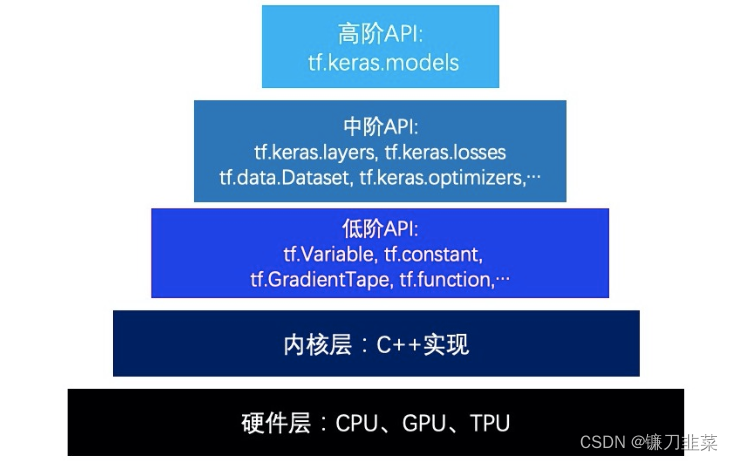
Tensorflow的低阶API示例
低阶API主要包括张量操作,计算图和自动微分。
import tensorflow as tf
#打印时间分割线
@tf.function
def printbar():
today_ts = tf.timestamp() % (24 * 60 * 60)
hour = tf.cast(today_ts // 3600 + 8, tf.int32) % tf.constant(24)
minite = tf.cast((today_ts % 3600) // 60, tf.int32)
second = tf.cast(tf.floor(today_ts % 60), tf.int32)
def timeformat(m):
if tf.strings.length(tf.strings.format("{}", m)) == 1:
return (tf.strings.format("0{}", m))
else:
return (tf.strings.format("{}", m))
timestring = tf.strings.join([timeformat(hour), timeformat(minite), timeformat(second)], separator=":")
tf.print("==========" * 8 + timestring)
下面使用TensorFlow的低阶API实现线性回归模型和DNN二分类模型:
线性回归模型
准备数据
import numpy as np
import pandas as pd
from matplotlib import pyplot as plt
import tensorflow as tf
# 样本数量
n = 400
# 生成测试用数据集
X= tf.random.uniform([n,2], minval=-10, maxval=10)
w0 = tf.constant([[2.0], [-3.0]])
b0 = tf.constant([[3.0]])
# @表示矩阵惩罚,并增加正态扰动
Y = X@w0+b0+tf.random.normal([n,1],mean=0.0, stddev=2.0)
数据可视化:
%matplotlib inline
%config InlineBackend.figure_format = 'svg'
# 数据可视化
plt.figure(figsize=(12, 5))
ax1 = plt.subplot(121)
ax1.scatter(X[:,0], Y[:,0], c='b')
plt.xlabel('x1')
plt.ylabel('y', rotation = 0)
ax2 = plt.subplot(122)
ax2.scatter(X[:,1],Y[:,0],c='g')
plt.xlabel('x2')
plt.ylabel('y', rotation=0)
plt.show()

构建数据管道迭代器:
def data_iter(features, labels, batch_size=8):
num_examples = len(features)
indices = list(range(num_examples))
np.random.shuffle(indices) # 样本的读取顺序是随机的
for i in range(0, num_examples, batch_size):
indexs = indices[i: min(i + batch_size, num_examples)]
yield tf.gather(features,indexs), tf.gather(labels, indexs)
# 测试数据管道效果
batch_size = 8
(features, labels) = next(data_iter(X, Y, batch_size))
print(features)
print(labels)
数据管道效果:
tf.Tensor(
[[-5.076039 -0.9657364 ]
[-6.358912 -3.6004496 ]
[-7.056513 -3.9889216 ]
[ 2.3329067 -2.8891182 ]
[-5.9270716 -8.905029 ]
[-0.16547203 -3.6211562 ]
[ 6.9834538 -1.579752 ]
[-5.3834534 2.5390549 ]], shape=(8, 2), dtype=float32)
tf.Tensor(
[[ -1.4625118]
[ 1.6316607]
[ 2.0894573]
[ 12.264805 ]
[ 16.555326 ]
[ 10.086447 ]
[ 21.4322 ]
[-14.078172 ]], shape=(8, 1), dtype=float32)
定义模型
w = tf.Variable(tf.random.normal(w0.shape))
b = tf.Variable(tf.zeros_like(b0, dtype=tf.float32))
# 定义模型
class LinearRegression:
# 正向传播
def __call__(self, x):
return x @ w + b
# 损失函数
def loss_func(self, y_true, y_pred):
return tf.reduce_mean((y_true - y_pred) ** 2 / 2)
model = LinearRegression()
训练模型
- 使用动态图调试
# 使用动态图调试
def train_step(model, features, labels):
with tf.GradientTape() as tape:
predictions = model(features)
loss = model.loss_func(labels, predictions)
# 反向传播求梯度
dloss_dw, dloss_db = tape.gradient(loss, [w, b])
# 梯度下降法更新参数
w.assign(w - 0.001*dloss_dw)
b.assign(b - 0.001*dloss_db)
return loss
测试train_step效果:
batch_size = 10
(features, labels) = next(data_iter(X, Y, batch_size))
train_step(model, features, labels)
'''
<tf.Tensor: shape=(), dtype=float32, numpy=277.26096>
'''
定义模型训练函数:
def train_model(model, epochs):
for epoch in tf.range(1, epochs+1):
for features, labels in data_iter(X, Y, 10):
loss = train_step(model, features, labels)
if epoch%50==0:
tf.print('=========='*8)
tf.print('epoch =',epoch, "loss = ",loss)
tf.print('w = ',w)
tf.print('b = ',b)
train_model(model, epochs=200)
训练过程:
================================================================================
epoch = 50 loss = 0.846690834
w = [[1.99412823]
[-2.99952745]]
b = [[3.04354715]]
================================================================================
epoch = 100 loss = 1.1837182
w = [[1.99304128]
[-2.99331546]]
b = [[3.04392529]]
================================================================================
epoch = 150 loss = 1.58060181
w = [[1.99656463]
[-2.98927522]]
b = [[3.04404855]]
================================================================================
epoch = 200 loss = 2.5443294
w = [[2.00231266]
[-2.97837281]]
b = [[3.04363918]]
- 使用autograph机制转换成静态图加速
@tf.function
def train_step(model, features, labels):
with tf.GradientTape() as tape:
predictions = model(features)
loss = model.loss_func(labels, predictions)
# 反向传播求梯度
dloss_dw, dloss_db = tape.gradient(loss, [w, b])
# 梯度下降法更新参数
w.assign(w - 0.001 * dloss_dw)
b.assign(b - 0.001 * dloss_db)
return loss
def train_model(model, epochs):
for epoch in tf.range(1, epochs + 1):
for features, labels in data_iter(X, Y, 10):
loss = train_step(model, features, labels)
if epoch % 50 == 0:
tf.print('=========='*8)
tf.print("epoch =", epoch, "loss = ", loss)
tf.print("w =", w)
tf.print("b =", b)
train_model(model, epochs=200)
训练过程:
================================================================================
epoch = 50 loss = 1.16669047
w = [[1.99806643]
[-2.99671936]]
b = [[3.04368925]]
================================================================================
epoch = 100 loss = 1.40429044
w = [[2.00206447]
[-2.98451281]]
b = [[3.04383779]]
================================================================================
epoch = 150 loss = 1.7426182
w = [[1.98978758]
[-2.99107504]]
b = [[3.04403]]
================================================================================
epoch = 200 loss = 2.16272426
w = [[1.99508071]
[-2.98746681]]
b = [[3.04382515]]
结果可视化:
%matplotlib inline
%config InlineBackend.figure_format = 'svg'
plt.figure(figsize=(12, 5))
ax1 = plt.subplot(121)
ax1.scatter(X[:, 0], Y[:, 0], c="b", label="samples")
ax1.plot(X[:, 0], w[0] * X[:, 0] + b[0], "-r", linewidth=5.0, label="model")
ax1.legend()
plt.xlabel("x1")
plt.ylabel("y", rotation=0)
ax2 = plt.subplot(122)
ax2.scatter(X[:, 1], Y[:, 0], c="g", label="samples")
ax2.plot(X[:, 1], w[1] * X[:, 1] + b[0], "-r", linewidth=5.0, label="model")
ax2.legend()
plt.xlabel("x2")
plt.ylabel("y", rotation=0)
plt.show()

DNN二分类模型
准备数据
import pandas as pd
import numpy as np
import matplotlib.pyplot as plt
import tensorflow as tf
配置notebook的cell:
%matplotlib inline
%config InlineBackend.figure_format = 'svg'
生成正负样本:
# 正负样本数量
n_positive, n_negative = 2000, 2000
# 生成正样本,小圆环分布
r_p = 5.0 + tf.random.truncated_normal([n_positive,1], 0.0, 1.0)
theta_p = tf.random.uniform([n_positive,1], 0.0, 2*np.pi)
Xp = tf.concat([r_p*tf.cos(theta_p), r_p*tf.sin(theta_p)], axis=1)
Yp = tf.ones_like(r_p)
# 生成负样本, 大圆环分布
r_n = 8.0 + tf.random.truncated_normal([n_negative, 1], 0.0, 1.0)
theta_n = tf.random.uniform([n_negative, 1], 0.0, 2*np.pi)
Xn = tf.concat([r_n*tf.cos(theta_n), r_n*tf.sin(theta_n)], axis=1)
Yn = tf.zeros_like(r_n)
# 汇总数据
X = tf.concat([Xp, Xn], axis=0)
Y = tf.concat([Yp, Yn], axis=0)
可视化数据:
# 可视化
plt.figure(figsize=(6,6))
plt.scatter(Xp[:,0].numpy(), Xp[:,1].numpy(), c='r')
plt.scatter(Xn[:,0].numpy(), Xn[:,1].numpy(), c='g')
plt.legend(['positive','negative'])

构建数据管道迭代器:
# 构建数据管道迭代器
def data_iter(features, labels, batch_size=8):
num_examples = len(features)
indices = list(range(num_examples))
np.random.shuffle(indices) #样本的读取顺序是随机的
for i in range(0, num_examples, batch_size):
indexs = indices[i: min(i + batch_size, num_examples)]
yield tf.gather(features,indexs), tf.gather(labels,indexs)
# 测试数据管道效果
batch_size = 10
(features, labels) = next(data_iter(X, Y, batch_size))
print(features)
print(labels)
定义模型
这里利用tf.Module来组织模型变量:
class DNNModel(tf.Module):
def __init__(self, name=None):
super(DNNModel, self).__init__(name=name)
self.w1 = tf.Variable(tf.random.truncated_normal([2, 4]), dtype=tf.float32)
self.b1 = tf.Variable(tf.zeros([1, 4]), dtype=tf.float32)
self.w2 = tf.Variable(tf.random.truncated_normal([4, 8]), dtype=tf.float32)
self.b2 = tf.Variable(tf.zeros([1, 8]), dtype=tf.float32)
self.w3 = tf.Variable(tf.random.truncated_normal([8, 1]), dtype=tf.float32)
self.b3 = tf.Variable(tf.zeros([1, 1]), dtype=tf.float32)
# 正向传播
@tf.function(input_signature=[tf.TensorSpec(shape=[None, 2], dtype=tf.float32)])
def __call__(self, x):
x = tf.nn.relu(x @ self.w1 + self.b1)
x = tf.nn.relu(x @ self.w2 + self.b2)
y = tf.nn.sigmoid(x @ self.w3 + self.b3)
return y
# 损失函数(二元交叉熵)
@tf.function(input_signature=[tf.TensorSpec(shape=[None, 1], dtype=tf.float32),
tf.TensorSpec(shape=[None, 1], dtype=tf.float32)])
def loss_func(self, y_true, y_pred):
# 将预测值限制在1e-7以下, 1-1e-7以下,避免log(0)错误
eps = 1e-7
y_pred = tf.clip_by_value(y_pred, eps, 1.0 - eps)
bce = -y_true * tf.math.log(y_pred) - (1 - y_true) * tf.math.log(1 - y_pred)
return tf.reduce_mean(bce)
# 评估指标(准确率)
@tf.function(input_signature=[tf.TensorSpec(shape=[None, 1], dtype=tf.float32),
tf.TensorSpec(shape=[None, 1], dtype=tf.float32)])
def metric_func(self, y_true, y_pred):
y_pred = tf.where(y_pred > 0.5, tf.ones_like(y_pred, dtype=tf.float32), tf.zeros_like(y_pred, dtype=tf.float32))
acc = tf.reduce_mean(1 - tf.abs(y_true - y_pred))
return acc
model = DNNModel()
测试模型结构:
batch_size = 10
(features, labels) = next(data_iter(X, Y, batch_size))
predictions = model(features)
loss = model.loss_func(labels, predictions)
metric = model.metric_func(labels, predictions)
tf.print("init loss:", loss)
tf.print("init metric", metric)
'''
init loss: 0.475380838
init metric 0.8
'''
print(len(model.trainable_variables)) # 6
训练模型
使用autograph机制转换成静态图加速:
@tf.function
def train_step(model, features, labels):
# 正向传播,计算损失
with tf.GradientTape() as tape:
predictions = model(features)
loss = model.loss_func(labels, predictions)
# 反向传播,计算梯度
grads = tape.gradient(loss, model.trainable_variables)
# 执行梯度下降
for p, dloss_dp in zip(model.trainable_variables, grads):
p.assign(p - 0.001 * dloss_dp)
# 计算评估指标
metric = model.metric_func(labels, predictions)
return loss, metric
def train_model(model, epochs):
for epoch in tf.range(1, epochs + 1):
for features, labels in data_iter(X, Y, 100):
loss, metric = train_step(model, features, labels)
if epoch % 100 == 0:
print('======='*10)
tf.print("epoch =", epoch, "loss = ", loss, "accuracy = ", metric)
train_model(model, epochs=600)
训练记录:
======================================================================
epoch = 100 loss = 0.544845939 accuracy = 0.79
======================================================================
epoch = 200 loss = 0.475 accuracy = 0.85
======================================================================
epoch = 300 loss = 0.391879201 accuracy = 0.88
======================================================================
epoch = 400 loss = 0.378405839 accuracy = 0.92
======================================================================
epoch = 500 loss = 0.289739966 accuracy = 0.98
======================================================================
epoch = 600 loss = 0.310408324 accuracy = 0.87
结果可视化:
fig, (ax1, ax2) = plt.subplots(nrows=1, ncols=2, figsize=(12, 5))
ax1.scatter(Xp[:, 0], Xp[:, 1], c="r")
ax1.scatter(Xn[:, 0], Xn[:, 1], c="g")
ax1.legend(["positive", "negative"]);
ax1.set_title("y_true");
Xp_pred = tf.boolean_mask(X, tf.squeeze(model(X) >= 0.5), axis=0)
Xn_pred = tf.boolean_mask(X, tf.squeeze(model(X) < 0.5), axis=0)
ax2.scatter(Xp_pred[:, 0], Xp_pred[:, 1], c="r")
ax2.scatter(Xn_pred[:, 0], Xn_pred[:, 1], c="g")
ax2.legend(["positive", "negative"]);
ax2.set_title("y_pred");
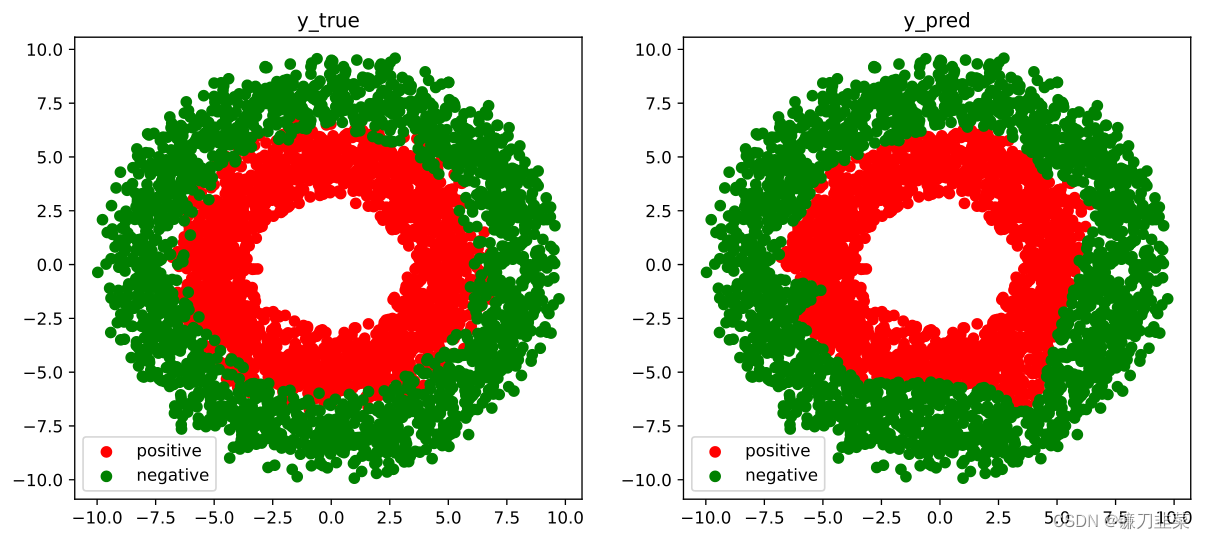
Tensorflow的中阶API示例
TensorFlow的中阶API主要包括各种模型层,损失函数,优化器,数据管道,特征列等。
线性回归模型
构建输入数据管道
ds = tf.data.Dataset.from_tensor_slices((X, Y)).shuffle(buffer_size=100).batch(10).prefetch(tf.data.experimental.AUTOTUNE)
定义模型
from tensorflow.keras import layers,losses,metrics,optimizers
model = layers.Dense(units=1)
model.build(input_shape=(2,)) # 用build方法创建variables
model.loss_func = losses.mean_squared_error
model.optimizer = optimizers.SGD(learning_rate=0.001)
训练模型:
使用autograph机制转换成静态图加速
@tf.function
def train_step(model, features, labels):
with tf.GradientTape() as tape:
predictions = model(features)
loss = model.loss_func(tf.reshape(labels, [-1]), tf.reshape(predictions, [-1]))
grads = tape.gradient(loss, model.variables)
model.optimizer.apply_gradients(zip(grads, model.variables))
return loss
# 测试train_step效果
features, labels = next(ds.as_numpy_iterator())
train_step(model, features, labels)
训练模型:
def train_model(model, epochs):
for epoch in tf.range(1, epochs + 1):
loss = tf.constant(0.0)
for features, labels in ds:
loss = train_step(model, features, labels)
if epoch % 50 == 0:
print('=======' * 10)
tf.print("epoch =", epoch, "loss = ", loss)
tf.print("w =", model.variables[0])
tf.print("b =", model.variables[1])
train_model(model, epochs=200)
训练结果:
======================================================================
epoch = 50 loss = 0.164111629
w = [[0.00108379347]
[-0.0043063662]]
b = [0.401051134]
======================================================================
epoch = 100 loss = 0.168586373
w = [[-0.00195285561]
[-0.00462398]]
b = [0.401163816]
======================================================================
epoch = 150 loss = 0.159221083
w = [[-0.0010873822]
[-0.00306460424]]
b = [0.4011105]
======================================================================
epoch = 200 loss = 0.157091931
w = [[0.0010298203]
[-0.00437747035]]
b = [0.401103854]
DNN二分类模型
构建输入数据管道
ds = tf.data.Dataset.from_tensor_slices((X, Y)).shuffle(buffer_size=4000).batch(100).prefetch(tf.data.experimental.AUTOTUNE)
定义模型:
class DNNModel(tf.Module):
def __init__(self, name=None):
super(DNNModel, self).__init__(name=name)
self.dense1 = layers.Dense(4, activation='relu')
self.dense2 = layers.Dense(8, activation='relu')
self.dense3 = layers.Dense(1, activation='sigmoid')
# 正向传播
@tf.function(input_signature=[tf.TensorSpec(shape=[None, 2], dtype=tf.float32)])
def __call__(self, x):
x = self.dense1(x)
x = self.dense2(x)
y = self.dense3(x)
return y
model = DNNModel()
model.loss_func = losses.binary_crossentropy
model.metric_func = metrics.binary_crossentropy
model.optimizer = optimizers.Adam(learning_rate=0.001)
测试模型结构:
(features,labels) = next(ds.as_numpy_iterator())
predictions = model(features)
loss = model.loss_func(tf.reshape(labels,[-1]),tf.reshape(predictions,[-1]))
metric = model.metric_func(tf.reshape(labels,[-1]),tf.reshape(predictions,[-1]))
tf.print("init loss:",loss)
tf.print("init metric",metric)
训练模型:
使用autograph机制转换成静态图加速
@tf.function
def train_step(model, features, labels):
with tf.GradientTape() as tape:
predictions = model(features)
loss = model.loss_func(tf.reshape(labels,[-1]), tf.reshape(predictions,[-1]))
grads = tape.gradient(loss,model.trainable_variables)
model.optimizer.apply_gradients(zip(grads,model.trainable_variables))
metric = model.metric_func(tf.reshape(labels,[-1]), tf.reshape(predictions,[-1]))
return loss,metric
# 测试train_step效果
features,labels = next(ds.as_numpy_iterator())
train_step(model,features,labels)
模型训练:
def train_model(model,epochs):
for epoch in tf.range(1,epochs+1):
loss, metric = tf.constant(0.0),tf.constant(0.0)
for features, labels in ds:
loss,metric = train_step(model,features,labels)
if epoch%10==0:
print('=======' * 10)
tf.print("epoch =",epoch,"loss = ",loss, "accuracy = ",metric)
train_model(model,epochs = 60)
Tensorflow的高阶API示例
TensorFlow的高阶API主要为tf.keras.models提供的模型的类接口。使用Keras接口有以下3种方式构建模型:①使用Sequential按层顺序构建模型,②使用函数式API构建任意结构模型,③继承Model基类构建自定义模型。
线性回归模型
使用Sequential按层顺序构建模型,并使用内置model.fit方法训练模型(初级方法):
定义模型

训练模型
使用fit方法进行训练:
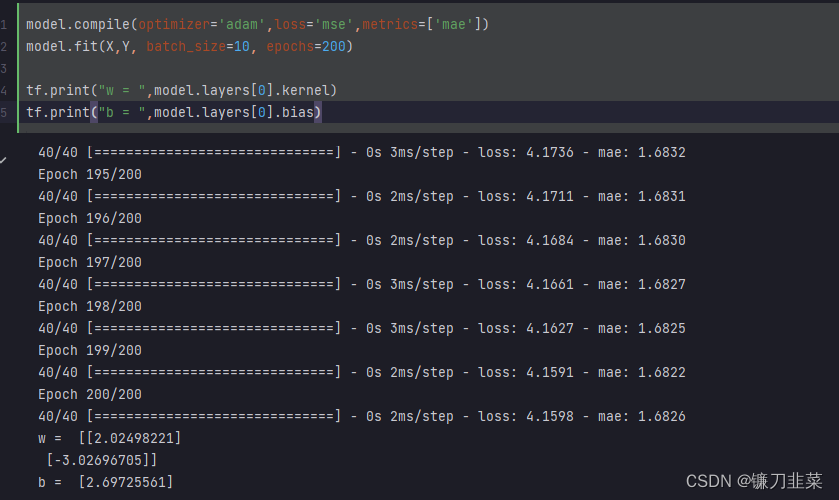
DNN二分类模型
使用继承Model基类构建自定义模型,并构建自定义训练循环(高级方法):
ds_train = tf.data.Dataset.from_tensor_slices((X[0:n*3//4,:],Y[0:n*3//4,:])).shuffle(buffer_size = 1000).batch(20).prefetch(tf.data.experimental.AUTOTUNE).cache()
ds_valid = tf.data.Dataset.from_tensor_slices((X[n*3//4:,:],Y[n*3//4:,:])).batch(20).prefetch(tf.data.experimental.AUTOTUNE).cache()
定义模型
tf.keras.backend.clear_session()
class DNNModel(models.Model):
def __init__(self):
super(DNNModel, self).__init__()
def build(self, input_shape):
self.dense1 = layers.Dense(4, activation="relu", name="dense1")
self.dense2 = layers.Dense(8, activation="relu", name="dense2")
self.dense3 = layers.Dense(1, activation="sigmoid", name="dense3")
super(DNNModel, self).build(input_shape)
# 正向传播
@tf.function(input_signature=[tf.TensorSpec(shape=[None, 2], dtype=tf.float32)])
def call(self, x):
x = self.dense1(x)
x = self.dense2(x)
y = self.dense3(x)
return y
model = DNNModel()
model.build(input_shape=(None, 2))
model.summary()
模型概览:
Model: "dnn_model"
_________________________________________________________________
Layer (type) Output Shape Param #
=================================================================
dense1 (Dense) multiple 12
dense2 (Dense) multiple 40
dense3 (Dense) multiple 9
=================================================================
Total params: 61
Trainable params: 61
Non-trainable params: 0
_________________________________________________________________
训练模型
自定义训练循环:
optimizer = optimizers.Adam(learning_rate=0.01)
loss_func = tf.keras.losses.BinaryCrossentropy()
train_loss = tf.keras.metrics.Mean(name='train_loss')
train_metric = tf.keras.metrics.BinaryAccuracy(name='train_accuracy')
valid_loss = tf.keras.metrics.Mean(name='valid_loss')
valid_metric = tf.keras.metrics.BinaryAccuracy(name='valid_accuracy')
@tf.function
def train_step(model, features, labels):
with tf.GradientTape() as tape:
predictions = model(features)
loss = loss_func(labels, predictions)
grads = tape.gradient(loss, model.trainable_variables)
optimizer.apply_gradients(zip(grads, model.trainable_variables))
train_loss.update_state(loss)
train_metric.update_state(labels, predictions)
@tf.function
def valid_step(model, features, labels):
predictions = model(features)
batch_loss = loss_func(labels, predictions)
valid_loss.update_state(batch_loss)
valid_metric.update_state(labels, predictions)
def train_model(model, ds_train, ds_valid, epochs):
for epoch in tf.range(1, epochs + 1):
for features, labels in ds_train:
train_step(model, features, labels)
for features, labels in ds_valid:
valid_step(model, features, labels)
logs = 'Epoch={},Loss:{},Accuracy:{},Valid Loss:{},Valid Accuracy:{}'
if epoch % 100 == 0:
print('=======' * 10)
tf.print(tf.strings.format(logs,
(epoch, train_loss.result(), train_metric.result(), valid_loss.result(),
valid_metric.result())))
train_loss.reset_states()
valid_loss.reset_states()
train_metric.reset_states()
valid_metric.reset_states()
train_model(model, ds_train, ds_valid, 1000)
参考资料
[1] 《30天吃掉那只Tensorflow》
